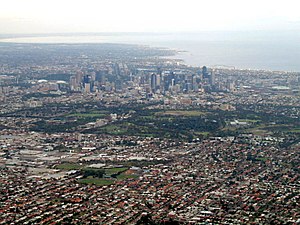 Image via Wikipedia
Image via WikipediaReport on Public Health and Urban Sprawl in Ontario - A review of the pertinent literature (53 page pdf, Riina Bray,Catherine Vakil MD, David Elliott, Environmental Health Committee, Ontario College of Family Physicians, Jan. 2005)
Today we review a report from the environmental health community on the negative impacts that sprawl has on the province of Ontario. The report emphasizes health impacts and air pollution that accompany sprawl driven, literally, by an increase in commuting traffic on municipal roadways.
Key Quotes:
“the pathway from urban sprawl to public health via vehicle emissions and air pollution will be examined, along with reviews of the relationship of sprawl to increased driving”
“Unless the current trends change, the hours of delay experienced by auto drivers is expected to rise by 300% over the next 27 years, with a 42% increase in carbon dioxide emissions per capita”
“The dependence on the private vehicle, and its resulting development patterns, seems to be irreversible and is self perpetuating: as the suburbs expand, their greater political weight increases the demand for more roads and more lanes, resists the financing of public transit infrastructure and accelerates declining ridership”
“The environmental problems that result from uncontrolled urban growth are numerous…include flooding, which results from increased impervious surfaces for roads and parking; increased temperatures from heat islands, which leads to a significant increased risk of mortality in elderly populations; decreases in natural areas and forests, and increased incidences of water pollution and water-borne disease”
“Concentrations of particulates emitted from vehicles are greatest near the roadway, and decrease to background levels at 300m… Levels of particulate (PM2.5) near busy roads can be 30% higher than background levels….CO and NOx follow a similar pattern”
“Local traffic-related air pollution also affects mortality. Finkelstein found that people living close to a major road had an increased risk of mortality, and that the mortality rate advancement period was 2.5 years”
“The effects of short-term exposure to traffic pollution have also recently been highlighted. Traveling in an automobile or bus, or riding a motorcycle or bicycle in polluted streets, is thought to be a triggering factor for myocardial infarction”
“Children living in communities with higher levels of NO2 and other traffic-related pollution, including PM2.5, had lung function growth that was approximately 10% slower than that of children in lower air pollution communities”
“the transportation sector represents one of the largest sources of GHG emissions in Canada, accounting for 24.7% of total emissions in 2000 (179 MTons [Megatons]). On-road transportation was the largest contributor of total emissions in this sector, at 72.7%”
Related articles
- Neighbourhood-Scale Air Pollution Exposure, Walkability and Heart Disease (pollutionfree.wordpress.com)
- Population, Traffic Density and Air Pollution in Large Cities (pollutionfree.wordpress.com)
- Exposure of Schoolchildren to Traffic-Related Air Pollution (pollutionfree.wordpress.com)
- EU agency: air pollution costs exceed $134 billion (seattletimes.nwsource.com)
- Reviewing the air pollution death and health impact numbers and peer reviewed epidemiological studies (nextbigfuture.com)
- EU agency: air pollution costs exceed $134 billion (seattlepi.com)
- Air Pollution Preconditions for Heart Attacks (pollutionfree.wordpress.com)
- Air Pollution Exposure and the Health of Neighbourhoods in Ottawa, Canada (pollutionfree.wordpress.com)
- Health Care Availability and Air Pollution Impacts (pollutionfree.wordpress.com)
- Buildings Showing their Rear to the Street (nclurbandesign.org)

No comments:
Post a Comment